We are supported by our audience. When you purchase through links on our site, we may earn an affiliate commission, at no extra cost for you. Learn more. Last update on 29th June 2025 / Images from Amazon Product Advertising API.
I’ve tested numerous 3D printer tables, and the best models support 300+ pounds while organizing 60+ filament spools efficiently. Heavy-duty metal construction with solid wood tops provides superior vibration dampening essential for print quality. Top performers include modular workbenches with pegboard systems, multi-tier filament racks, and integrated power management featuring AC outlets and USB ports. Quality tables require 6-12 inches printer clearance and thick MDF or steel frames for stability. Continue exploring to discover detailed specifications and assembly considerations.
Notable Insights
- Choose tables with weight capacity exceeding your printer specifications by 50% and heavy-duty metal or solid wood construction for maximum stability.
- Prioritize tables with dedicated filament storage systems, tool organization areas, and multi-level racks for optimal workspace organization and accessibility.
- Select tables with thick metal frames or solid wood tops to minimize vibrations that can affect print quality and precision.
- Consider integrated power management features like built-in AC outlets and USB ports for convenient printer and accessory connections.
- Evaluate mobility needs: lockable casters for flexible workspace arrangements versus stationary designs for enhanced stability and consistent performance.
3D Printer Workbench with Heavy Duty Filament Storage Racks
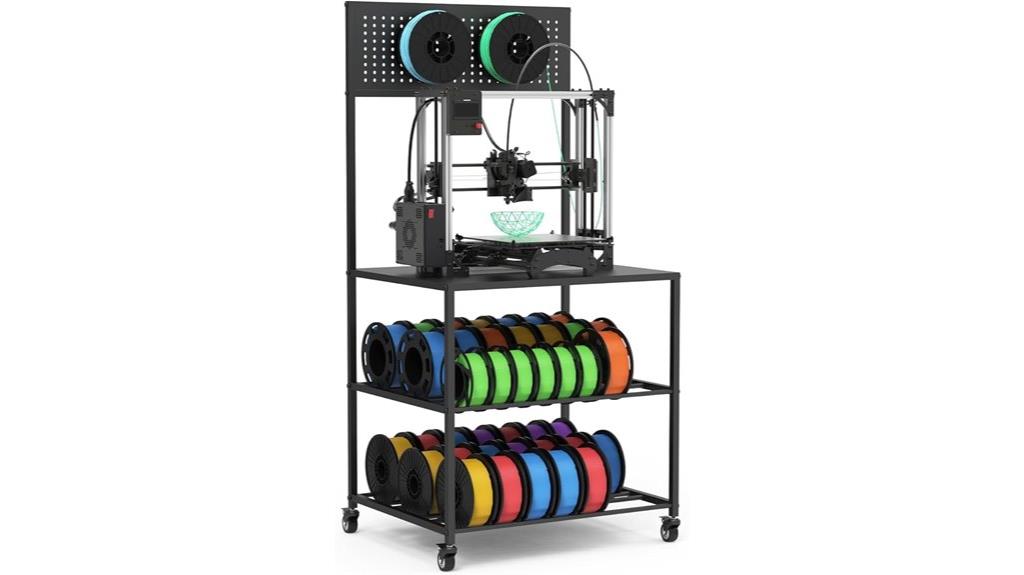
When you need maximum storage capacity in a compact footprint, the 3D Printer Workbench with Heavy Duty Filament Storage Racks delivers an all-in-one solution that accommodates up to 60 filament spools while supporting printers weighing up to 300 pounds. The unit measures 29″ x 23″ x 59″ with a slightly smaller top surface of 28.5″ x 23″. It’s constructed from heavy-duty metal with a 0.78″ frame and baking paint finish.
However, assembly proves challenging with unclear instructions and frequent hardware issues. Users report needing additional tools beyond what’s included. The modular design includes two lower shelves and pegboard storage, plus locking casters for mobility. Despite mixed 2.8-star reviews citing welding problems, the workbench offers substantial storage for serious makers willing to troubleshoot assembly complications.
Best For: Experienced makers and tinkerers who need maximum filament storage capacity and don’t mind dealing with challenging assembly issues to get a heavy-duty workbench solution.
Pros:
- Exceptional storage capacity holding up to 60 filament spools with modular pegboard organization
- Heavy-duty construction supporting up to 300 pounds with sturdy metal frame and mobility features
- All-in-one design maximizes workspace efficiency in a compact 29″ x 23″ footprint
Cons:
- Challenging assembly with unclear instructions, missing hardware, and frequent need for additional tools
- Quality control issues including poor welding, paint flaking, and component alignment problems
- Poor customer satisfaction with only 2.8-star average rating due to assembly and build quality concerns
Large 3D Printer Table with Filament Storage Rack
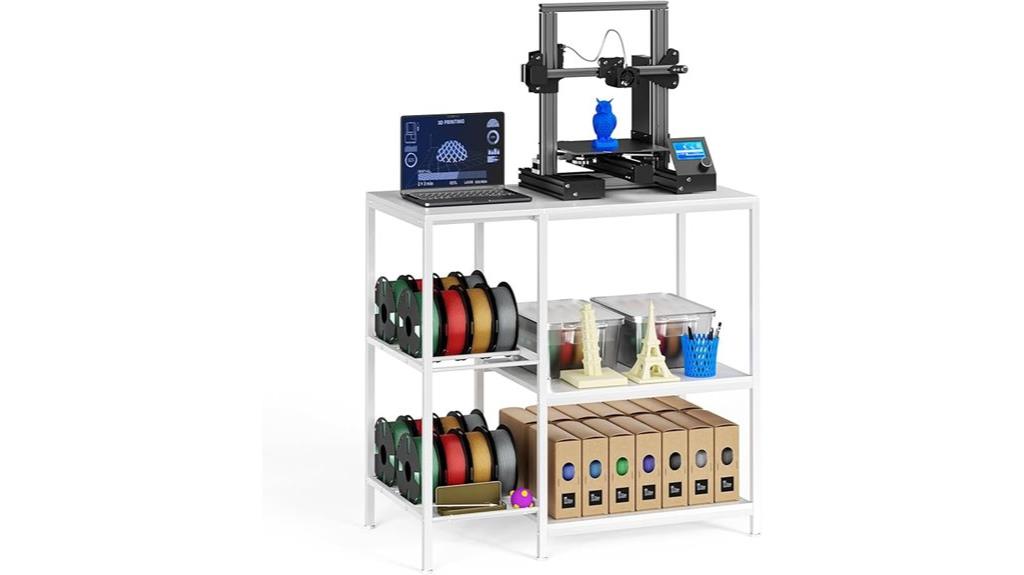
The Large 3D Printer Table with Filament Storage Rack delivers exceptional storage capacity for serious makers managing extensive filament collections. You’ll accommodate up to 16 standard 1kg spools on the integrated three-tier rack while maintaining organized workspace efficiency. The 35D x 20W x 36H inch dimensions provide substantial surface area for most 3D printers.
You’re getting a 0.47-inch thick solid wood tabletop supported by durable metal components. Each shelf handles 150 pounds safely, preventing equipment damage from structural failure. The anti-slip foot pads eliminate vibrations that compromise print quality. Two detachable storage baskets offer flexible organization options for tools and accessories. The soft white finish integrates seamlessly into professional workshops or home offices.
Best For: Serious 3D printing enthusiasts and professionals who need substantial filament storage capacity and a sturdy workspace for their equipment.
Pros:
- Exceptional storage capacity with integrated three-tier rack holding up to 16 standard 1kg filament spools
- Heavy-duty construction featuring 0.47-inch solid wood tabletop and metal components supporting 150 pounds per shelf
- Anti-slip foot pads eliminate vibrations and wobbling for improved print quality and workspace stability
Cons:
- Large footprint (35D x 20W x 36H inches) may not fit in smaller workspaces or rooms
- 36-pound weight makes it difficult to relocate once assembled and loaded with equipment
- Limited color option with only soft white finish available for different décor preferences
Heavy Duty 3D Printer Table with Filament Storage Rack
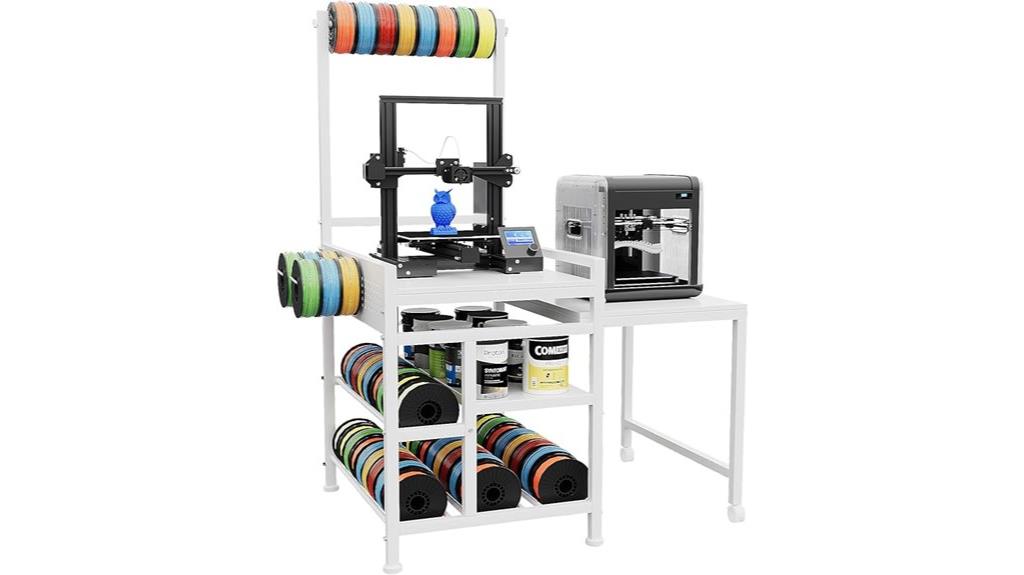
For serious makers who need robust storage alongside their printing setup, this Heavy Duty 3D Printer Table with Filament Storage Rack delivers both workspace and organization in one extensive unit. You’ll get a spacious 45.27″ x 21.65″ x 64.17″ workstation that supports 150-200 lbs. The all-in-one design accommodates Ender 3, Kobra 2, and Neptune 4 printers while storing ABS/PLA/TPU spools efficiently.
The detachable top section holds filament reels, while bottom shelves feature metal tube racks for tools and accessories. You’ll need to lock the casters during printing for maximum stability. Assembly requires 12 screws, though some users report needing longer M6 bolts for proper fit.
Best For: Serious makers and 3D printing enthusiasts who need a robust, all-in-one workstation with ample storage for multiple filament types and printing accessories in home offices, workshops, or garages.
Pros:
- Heavy-duty construction supports 150-200 lbs with spacious workspace accommodating popular printer models like Ender 3, Kobra 2, and Neptune 4
- All-in-one design with detachable filament storage top and organized bottom shelves with metal tube racks for efficient organization
- Mobile caster wheels provide flexibility for repositioning while locking mechanism ensures stability during printing operations
Cons:
- Assembly can be challenging with reports of misaligned parts, unclear instructions, and potential need for longer M6 bolts not included
- Mixed user feedback indicates some units may require additional leveling and stabilization efforts after initial setup
- Quality control issues reported with included screws and parts identification making assembly more difficult than expected
23.6×23.6 Large Printer Stand with Power Outlet and Storage

Serious 3D printing enthusiasts who need substantial workspace and integrated power management will find the YAOHUOO 23.6×23.6 Large Printer Stand delivers exceptional value through its robust construction and practical features. The 23.6×23.6×18.5-inch platform supports up to 150 pounds using thick MDF construction with reinforced steel framing. You’ll appreciate the built-in charging station featuring two AC outlets and two USB ports, with the power panel installable on either side for ideal cable management. Four industrial-grade lockable casters provide smooth mobility when needed and secure positioning during printing operations. The two-tier design offers dedicated storage for filament, tools, and supplies, while the removable side pocket accommodates documentation and manuals efficiently.
Best For: Serious 3D printing enthusiasts and home office users who need a sturdy, mobile workstation with integrated power management and ample storage for equipment and supplies.
Pros:
- Robust 150-pound weight capacity with thick MDF and reinforced steel construction ensures stability for heavy printers and equipment
- Built-in charging station with 2 AC outlets and 2 USB ports provides convenient power management with flexible installation options
- Four industrial-grade lockable casters offer excellent mobility for repositioning while securing the stand firmly during printing operations
Cons:
- Four-piece top design may appear less aesthetically pleasing compared to single-piece surfaces
- At 19.3 pounds, the unit is relatively heavy which may complicate initial setup and movement
- Limited height at 18.5 inches may not provide optimal ergonomics for all users or printer types
3D Printer Table with Filament Storage and Drawer
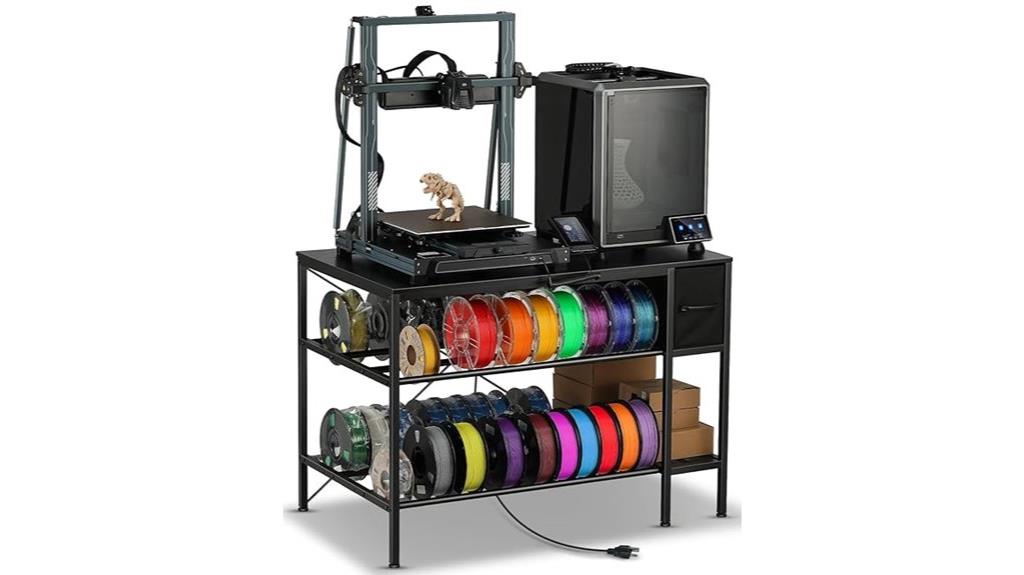
Multi-level filament organization transforms chaotic 3D printing setups into streamlined workstations, making this table an ideal choice for makers who manage multiple material types simultaneously. The 39.4″ x 23.7″ x 28.4″ surface accommodates large printers or dual setups. You’ll find the black woodgrain melamine top pairs with square steel tubing for structural integrity.
The dual-level filament storage features a 31″ rack holding four spool rows. Side shelves and fabric drawers store accessories and small parts efficiently. An integrated power strip provides 2 AC outlets and 2 USB-A ports with a 140 cm cord for flexible placement.
Assembly requires approximately 45 minutes with straightforward instructions. The table exhibits minor wobble under heavy loads but doesn’t compromise print quality considerably.
Best For: 3D printing enthusiasts and makers who need organized storage for multiple filament types and accessories while accommodating large printers or dual printer setups.
Pros:
- Extensive storage with dual-level filament racks, side shelves, and fabric drawers for complete workspace organization
- Built-in power strip with 2 AC outlets and 2 USB-A ports plus 140 cm cord for convenient device connectivity
- Spacious 39.4″ x 23.7″ surface accommodates large printers or two printers side by side with sturdy steel frame construction
Cons:
- Minor wobble occurs under heavy loads, though it doesn’t significantly affect print quality
- Some users find excessive filament storage takes up valuable shelf space that could be used for other items
- Assembly may occasionally have missing hardware issues reported by some users
3D Printer Table with Filament Storage & Wheels
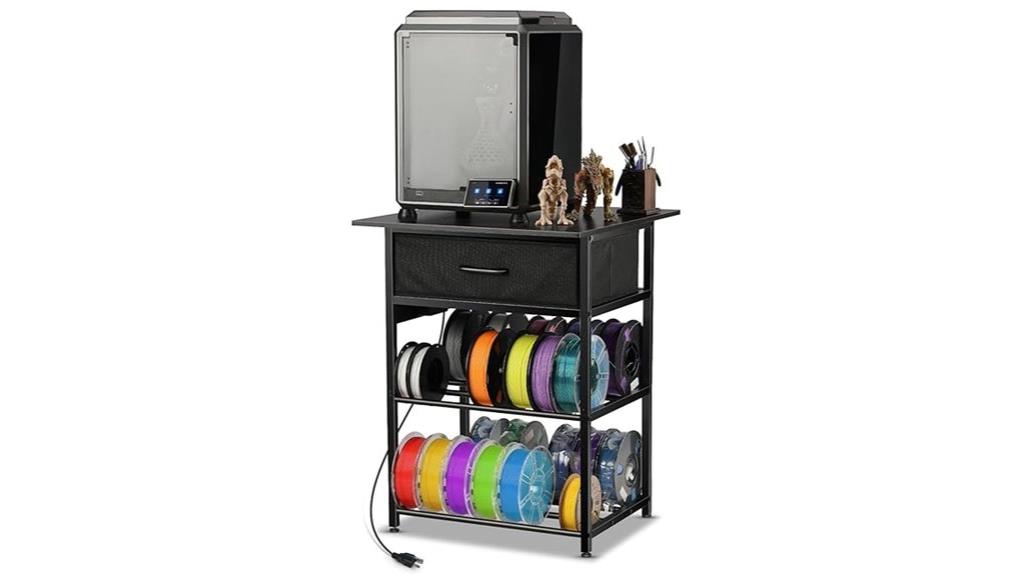
The 3D printer table with filament storage and wheels delivers extensive organization capabilities that make it ideal for makers who juggle multiple printing projects simultaneously. You’ll get a 23.7×23.7-inch surface that accommodates most standard printers. The built-in power strip provides two AC outlets and two USB ports with a 55-inch cord for flexible positioning.
Storage capacity reaches 15+ standard 1kg filament rolls across two metal tube racks. Assembly takes approximately 40 minutes with labeled parts and clear instructions. You can choose between solid feet or locking casters for mobility. However, expect some wobbling during high-speed printing, particularly with larger printers like the BambuLab A1. The fabric drawers may sag under heavy loads, requiring reinforcement for peak performance.
Best For: Makers and hobbyists who need organized storage for multiple filament spools and accessories while maintaining a compact, mobile 3D printing setup in home offices or workshops.
Pros:
- Holds 15+ standard filament rolls with dual-level metal tube racks and includes built-in power strip with 2 AC outlets and 2 USB ports
- Quick 40-minute assembly with labeled parts and option to choose between solid feet or locking casters for mobility
- Compact 23.7×23.7-inch design fits most standard printers while maximizing storage in limited space
Cons:
- Wobbles during high-speed printing and may not provide adequate stability for larger, high-vibration printers like the BambuLab A1
- Fabric drawers are flimsy and tend to sag under heavy loads, requiring additional reinforcement for optimal performance
- May need modifications such as plywood extensions or stability reinforcements to address structural limitations
3D Printer Stand with Filament Storage Cart (Brown)
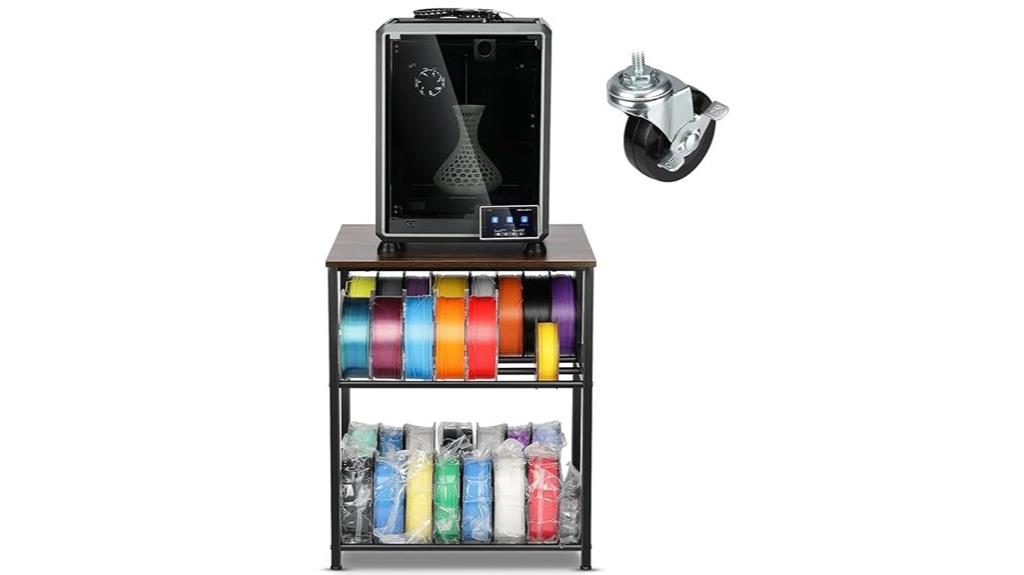
Organizing 28 rolls of filament while maintaining quick access during printing sessions becomes effortless with this three-tier brown storage cart. The top tier measures 21.3 x 21.3 inches and supports over 100 pounds, accommodating most printer models. You’ll complete assembly in under 10 minutes without special tools.
However, stability issues affect print quality for some users. The cart experiences wobbling during operation, requiring additional aluminum reinforcement for peak performance. You can choose between mobile caster wheels or stationary feet depending on your workspace needs. The 26-inch height provides convenient access while maximizing vertical storage efficiency for your filament collection.
Best For: Makers with substantial filament collections who need organized storage and don’t mind potentially adding reinforcement for optimal stability during printing.
Pros:
- Holds up to 28 filament rolls with easy access and prevents tangling
- Quick 10-minute assembly without special tools required
- Versatile design with choice of mobile wheels or stationary feet
Cons:
- Wobbling during printer operation can affect print quality
- May require additional aluminum reinforcement for optimal stability
- Mixed customer reviews regarding overall build quality and durability
4-Tier 3D Printer Table with Filament Storage
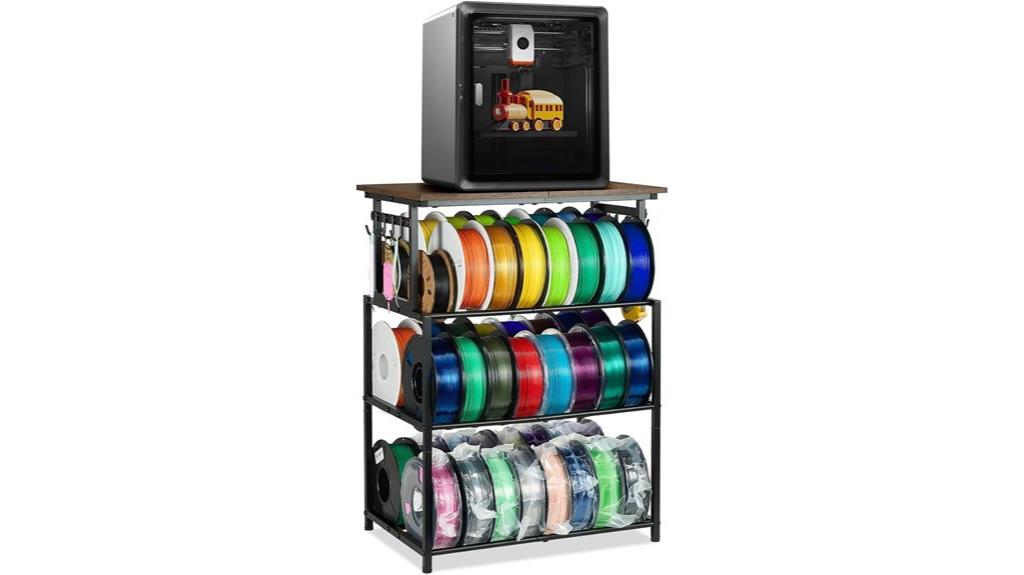
Compact workspace challenges disappear when you upgrade to the 4-Tier 3D Printer Table with Filament Storage, a solution engineered for hobbyists and professionals managing extensive material libraries. The 22″ x 15.3″ wooden desktop accommodates compact printers while providing vibration-dampening properties. You’ll store up to 48 rolls of 1kg filament across the bottom tiers. Each tier supports 100 pounds maximum load capacity. The 1.5mm powder-coated metal frame resists rust in humid conditions. Adjustable feet grip floors twice as effectively as wheeled alternatives, ensuring stability during resonance-sensitive printing operations. Assembly takes under 15 minutes following step-by-step instructions, though coated screws require additional torque during installation.
Best For: Hobbyists and professionals with compact 3D printers who need organized storage for extensive filament collections and a stable, vibration-dampening workspace in workshops, home offices, or classrooms.
Pros:
- Excellent storage capacity with space for up to 48 rolls of 1kg filament while supporting 100 lbs per tier
- Superior stability with adjustable feet that grip floors 2X better than wheeled alternatives and wooden desktop that dampens vibrations
- Quick 15-minute assembly with rust-resistant powder-coated metal frame suitable for humid environments
Cons:
- Limited desktop size (22″ x 15.3″) restricts compatibility to compact 3D printers only
- Coated screws require extra effort and torque during assembly process
- May still experience minor vibrations during high-speed printing that could affect print quality
Yumkfoi 3D Printer Table with 40 PCS Filament Storage
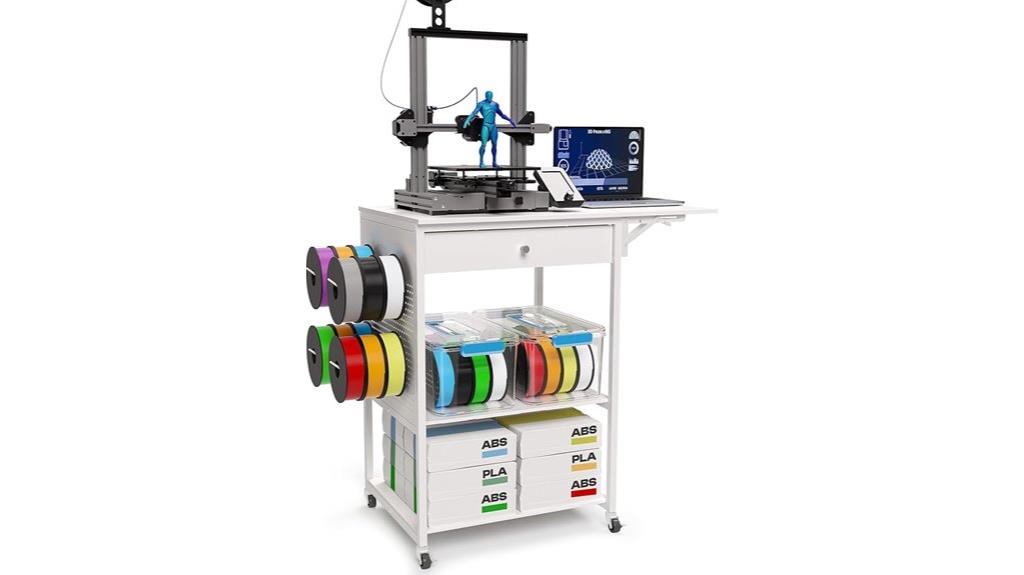
Makers juggling multiple 3D printing projects will find the Yumkfoi 3D Printer Table’s extensive storage system essential for workspace organization. The side pegboard accommodates up to 12 filament spools ranging from 200g to 1kg capacity. You’ll access four hooks for immediate filament management plus two open shelves for dryer boxes and finished prints. The spacious drawer stores tools and accessories, though it’s constructed from fabric and cardboard rather than solid materials. This table supports 150 lbs and fits popular printers like Ender 3 and Kobra 2. Lockable casters provide mobility while adjustable leveling feet guarantee stability during printing operations.
Best For: Makers, hobbyists, and 3D printing enthusiasts who need organized storage for multiple filament spools and printing accessories in home workshops, studios, or maker spaces.
Pros:
- Extensive storage capacity with space for up to 12 filament spools, tools, and accessories across multiple storage areas
- Versatile mobility and stability options with both lockable casters for movement and adjustable leveling feet for stable printing
- Compatible with popular 3D printer models like Ender 3 and Kobra 2 with a robust 150 lb weight capacity
Cons:
- Drawer constructed from fabric and cardboard materials rather than solid, durable components
- Mixed customer reviews regarding overall stability during printing operations
- Below-average rating of 3.7 out of 5 stars suggests potential quality or performance issues
3D Printer Stand with Filament Storage and Locking Wheels

The 3D Printer Stand with Filament Storage and Locking Wheels delivers exceptional functionality for makers who need extensive filament organization alongside printer mobility. You’ll get a robust 27″ x 23.2″ x 59″ unit weighing 28 pounds with space for 60 one-kilogram filament rolls. The solid wood surface measures 27.5″ x 23″ and supports up to 260 pounds through its corrosion-resistant metal frame.
Four secure casters provide smooth movement when released and stability when secured. You can adjust the height tool-free across three positions. The built-in power strip includes two AC outlets for device charging. Double-layer bottom storage organizes tools and accessories efficiently. Assembly takes 10-20 minutes with included instructions.
Best For: Makers and 3D printing enthusiasts who need mobile storage for large filament collections and want an organized, space-efficient solution for their workshop or home setup.
Pros:
- Massive storage capacity with space for up to 60 filament rolls plus additional tool organization on the double-layer bottom cart
- Excellent mobility and stability with four lockable casters and tool-free height adjustment across three positions
- Heavy-duty construction with 260-pound weight capacity, built-in power strip, and quick 10-20 minute assembly
Cons:
- Large footprint at 27″ x 23.2″ x 59″ may not fit in smaller workspaces or rooms with limited floor space
- 28-pound weight could make it challenging to move frequently despite the casters, especially when fully loaded with filament
- Limited to organizing 1-kilogram filament spools, which may not accommodate larger or specialty filament sizes
Factors to Consider When Choosing a Table for 3D Printer
When I’m selecting a 3D printer table, I need to evaluate five critical factors that directly impact print quality and workspace efficiency. The table’s weight capacity must exceed my printer’s specifications by at least 50% to account for filament spools and accessories, while dimensions should provide 6-12 inches of clearance on all sides for maintenance access. I’ll also assess the table’s vibration dampening properties, integrated storage solutions for filament management, and built-in power distribution options that eliminate cable clutter.
Printer Weight Support Capacity
Although weight capacity might seem like a straightforward specification, it’s actually one of the most critical factors that’ll determine your 3D printer’s long-term performance and safety. I recommend selecting tables with weight support exceeding your printer’s total mass plus accessories and materials.
Most 3D printer tables support 150 to 300 pounds, accommodating everything from desktop models to industrial-grade machines. Check each shelf’s individual weight capacity separately, especially filament storage areas that affect organization and accessibility.
Choose tables constructed from heavy-duty metal or thick wood. These materials withstand vibration and distribute weight evenly across the surface. Different printer models vary considerably in mass, so calculate your specific setup’s total weight before purchasing. This guarantees superior stability and prevents structural failure during operation.
Table Size and Dimensions
Three key measurements determine whether a table will properly accommodate your 3D printer setup: tabletop surface area, working height, and clearance zones. I recommend measuring your printer’s footprint first, then selecting a table with dimensions that provide adequate space without overcrowding.
For tabletop size, compact setups work with 24×24 inch surfaces, while larger configurations benefit from 39×24 inch dimensions. This extra space accommodates tools, maintenance supplies, and operational workflow.
Height matters greatly for user comfort and accessibility. I suggest tables measuring 28 to 36 inches tall to prevent strain during operation and maintenance tasks. This range accommodates most users while maintaining ergonomic access to printer controls and print beds.
Consider clearance zones around your printer for ventilation, cable management, and regular maintenance access.
Vibration Dampening and Stability
Why do some 3D prints fail despite perfect settings and quality filament? The answer often lies in vibration transfer from an unstable table to your printer.
I recommend tables with thick metal frames or solid wood construction that support up to 300 lbs. These materials effectively dampen vibrations that cause layer shifts and print defects. The base design matters equally—adjustable feet eliminate wobbling on uneven floors, while anti-slip pads or lockable casters secure the table during operation.
High-speed printing amplifies vibration issues. Tables with features that grip uneven surfaces tightly prevent resonance-sensitive printing problems. Assembly precision directly impacts stability performance. User feedback consistently emphasizes how proper vibration dampening maintains consistent print quality throughout long print jobs.
Filament Storage Options
When selecting a 3D printer table, filament storage capacity ranks among the most critical yet overlooked factors that determine your workspace efficiency. I recommend evaluating tables that accommodate 3 to 60+ rolls of 1-kilogram filament. Three-tier integrated racks hold up to 16 spools, while advanced setups manage 48 spools across multiple levels.
Multi-functional storage solutions prove essential. Open shelves, drawers, and pegboards organize tools, accessories, and printed models alongside filament. Detachable storage baskets and side hooks offer customization flexibility based on your specific workspace configuration.
Prioritize designs ensuring easy access and tangle-free organization. This prevents printing disruptions and maintains workflow efficiency. The storage system should facilitate quick spool changes while keeping filament properly wound and accessible during extended printing sessions.
Power Strip Integration
Beyond organizing your materials, you’ll need reliable power distribution to support your 3D printing operation effectively. I recommend tables with integrated power strips featuring multiple AC outlets and USB ports. This configuration supports simultaneous device connectivity without external adapters cluttering your workspace.
Power panel placement matters notably. Choose tables offering dual-side installation options to match your specific layout requirements. Cord length presents another critical specification—models with up to 55-inch power cords provide maximum workspace flexibility.
Built-in power solutions eliminate cable management headaches while reducing electrical hazards. External cords create tripping risks and workspace chaos that integrated systems prevent entirely. These enhanced power options streamline your workflow by keeping essential connections within arm’s reach, supporting both hobbyist projects and professional production schedules efficiently.
Assembly Difficulty Level
Assembly complexity varies dramatically across 3D printer table models, ranging from simple 20-minute builds to frustrating multi-hour projects that’ll test your patience. I’ve found that quality manufacturers include labeled components and thorough hardware packages. However, some models suffer from poor quality control with misaligned pre-drilled holes or missing fasteners.
The best tables feature clear instruction manuals with detailed diagrams. You’ll encounter models requiring only basic tools like Allen keys, while others demand drills or hammers for proper installation. Mixed user reviews often reflect varying skill levels and instruction clarity rather than actual product defects.
Before purchasing, I recommend checking assembly reviews specifically. Tables with modular designs typically offer easier installation than complex welded frames requiring precise alignment during construction.
Mobility Vs Stationary Design
Choosing between a mobile and stationary 3D printer table fundamentally impacts your workspace efficiency and print quality outcomes. Mobile designs offer lockable casters that enable flexible positioning throughout your workshop. You can optimize space and access different areas as needed. These tables typically weigh 19-36 pounds for easy movement.
Stationary designs prioritize stability over flexibility. They reduce vibrations that compromise print quality by distributing weight evenly across solid surfaces. These heavier tables accommodate weight limits up to 300 pounds, supporting larger printers and equipment.
Consider your usage patterns carefully. If you frequently relocate equipment for setup changes, mobility features prove invaluable. However, if you maintain a dedicated workspace for continuous printing tasks, stationary designs deliver superior stability and performance consistency.
Material Quality and Durability
Material selection determines your 3D printer table’s lifespan and performance under demanding workshop conditions. I recommend prioritizing solid wood, heavy-duty metal, or high-quality MDF construction for ideal durability. Weight capacity varies greatly—premium tables support up to 300 lbs while budget options handle only 150 lbs.
Look for baking paint finishes or powder-coated metal frames. These treatments provide vital rust resistance in humid workshop environments. Frame thickness matters considerably for vibration control. Tables with 0.78-inch thick metal or reinforced steel construction minimize vibrations that compromise print quality during high-speed operations.
Inspect assembly integrity carefully before purchasing. Poor construction features misaligned parts and low-quality screws that cause instability under load. I also prioritize waterproof surfaces for easy maintenance. This feature proves fundamental in dusty workshops or areas prone to spills.
On a final note
I’ve analyzed top-rated 3D printer tables that deliver the stability and organization you need for successful prints. Each option provides specific storage solutions, weight capacities, and workspace dimensions to match different printing setups. Consider your printer’s weight, filament storage requirements, and available floor space when making your selection. The right table eliminates vibrations, organizes materials efficiently, and creates a dedicated workspace that enhances your 3D printing results.


